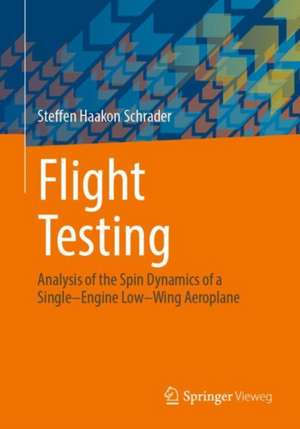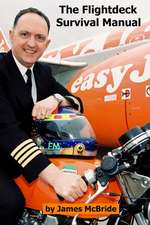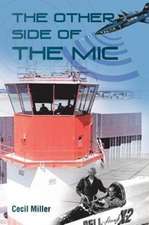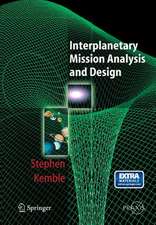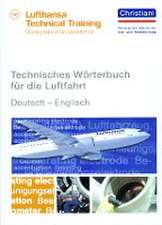Flight Testing: Analysis of the Spin Dynamics of a Single–Engine Low–Wing Aeroplane
Autor Steffen Haakon Schraderen Limba Engleză Paperback – 7 mar 2023
This book aims to contribute to a better understanding of the spin phenomenon through investigating the spin regime for normal, utility and aerobatic aircraft, and to explain what happens to the aircraft in terms of the aerodynamics, flight mechanics and the aircraft stability. The approach used is to vary the main geometric parameters such as the centre of gravity position and the aeroplane’s mass across the flight envelope, and to investigate the subsequent effect on the main spin characteristic parameters such as the angle of attack, pitch angle, sideslip angle, rotational rates, and recovery time.
First of all, a literature review sums up the range of technical aspects that affect the problem of spinning. It reviews the experimental measurement techniques used, theoretical methods developed and flight test results obtained by previous researchers. The published results have been studied to extract the effect on spinning of aircraft geometry, control surface effectiveness, flight operational parameters and atmospheric effects. Consideration is also made of the influence on human performance of spinning, the current spin regulations and the available training material for pilots.
A conventional-geometry, single-engine low-wing aeroplane, the basic trainer Fuji FA-200-160, has been instrumented with a proven digital flight measurement system and 27 spins have been systematically conducted inside and outside the certified flight envelope. The accuracy of the flight measurements is ensured through effective calibration, and the choice of sensors has varied through the study, with earlier sensors suffering from more drift than the current sensors (Belcastro, 2009 and Schrader, 2013).
In-flight parameter data collected includes left and right wing α and β-angles, roll-pitch-yaw angles and corresponding rates, all control surface deflections, vertical speeds, altitude losses and the aeroplane’s accelerations in all three directions.
Such data have been statistically analysed. The pitch behaviour has been mathematically modelled on the basis of the gathered flight test data.
Nine observations have been proposed. These mainly cover the effects of centre of gravity and aircraft mass variations on spin characteristic behaviour. They have all been proven as true through the results of this thesis. The final observation concerns the generalisation of the Fuji results, to the spin behaviour of other aircraft in the same category.
These observations can be used to improve flight test programmes, aircraft design processes, flight training materials and hence contribute strongly to better flight safety.
Preț: 644.18 lei
Preț vechi: 757.85 lei
-15% Nou
Puncte Express: 966
Preț estimativ în valută:
123.27€ • 131.81$ • 102.77£
123.27€ • 131.81$ • 102.77£
Carte disponibilă
Livrare economică 28 martie-11 aprilie
Preluare comenzi: 021 569.72.76
Specificații
ISBN-13: 9783662632178
ISBN-10: 3662632179
Pagini: 266
Ilustrații: XI, 266 p. 188 illus., 145 illus. in color.
Dimensiuni: 168 x 240 mm
Greutate: 0.52 kg
Ediția:1st ed. 2023
Editura: Springer Berlin, Heidelberg
Colecția Springer Vieweg
Locul publicării:Berlin, Heidelberg, Germany
ISBN-10: 3662632179
Pagini: 266
Ilustrații: XI, 266 p. 188 illus., 145 illus. in color.
Dimensiuni: 168 x 240 mm
Greutate: 0.52 kg
Ediția:1st ed. 2023
Editura: Springer Berlin, Heidelberg
Colecția Springer Vieweg
Locul publicării:Berlin, Heidelberg, Germany
Cuprins
Literature review.- Measurement system for spin test data acquisition.- Preparation of the aeroplane and the spin trials.- Spin description.- Mathematical spin test data analysis.- Flight test data comparison.
Notă biografică
Steffen H. Schrader is Associate Professor for Flight Test and Polar Aviation at ‘The Arctic University of Norway’ in Tromsø, he teaches at the ‘Empire Test Pilots’ School’ (ETPS) in Boscombe Down (UK) and he is Leader of an Aerospace Technology Degree Programme at the Osnabrueck University of Applied Sciences in close collaboration with the University of the West of England (Bristol) where he completed his PhD.
He studied Aerospace Technology at the Technical University of Braunschweig and the Coventry University (UK). He is Test Pilot according to EASA regulations since 2003, Airline Transport Pilot and Flying Instructor since more than 25 years.
He studied Aerospace Technology at the Technical University of Braunschweig and the Coventry University (UK). He is Test Pilot according to EASA regulations since 2003, Airline Transport Pilot and Flying Instructor since more than 25 years.
Textul de pe ultima copertă
As spinning is involved in around 60% of all aircraft accidents, this aerodynamic phenomenon is still not fully understood.
This book contributes to a better understanding of the spin through investigating the spin regime for normal, utility and aerobatic aircraft, and to explain what happens to the aircraft in terms of the aerodynamics, flight mechanics and the aircraft stability.
The approach used is to vary the main geometric parameters such as the center of gravity position and the aeroplane’s mass across the flight envelope, and to investigate the subsequent effect on the main spin characteristic parameters.
A conventional-geometry, single-engine low-wing aeroplane, has been instrumented with a proven digital flight measurement system and 27 spins have been systematically conducted inside and outside the certified flight envelope.
The data collected include left and right wing α and β-angles, roll-pitch-yaw angles and corresponding rates, all control surface deflections, vertical speeds, altitude losses and the aeroplane’s accelerations in all three directions. Such data have been statistically analysed and the pitch behaviour has been mathematically modelled.
These results can be used to improve flight test programmes, aircraft design processes, flight training materials and hence contribute strongly to better flight safety.
This book contributes to a better understanding of the spin through investigating the spin regime for normal, utility and aerobatic aircraft, and to explain what happens to the aircraft in terms of the aerodynamics, flight mechanics and the aircraft stability.
The approach used is to vary the main geometric parameters such as the center of gravity position and the aeroplane’s mass across the flight envelope, and to investigate the subsequent effect on the main spin characteristic parameters.
A conventional-geometry, single-engine low-wing aeroplane, has been instrumented with a proven digital flight measurement system and 27 spins have been systematically conducted inside and outside the certified flight envelope.
The data collected include left and right wing α and β-angles, roll-pitch-yaw angles and corresponding rates, all control surface deflections, vertical speeds, altitude losses and the aeroplane’s accelerations in all three directions. Such data have been statistically analysed and the pitch behaviour has been mathematically modelled.
These results can be used to improve flight test programmes, aircraft design processes, flight training materials and hence contribute strongly to better flight safety.
Caracteristici
No comparable scientific literature in this particular field (Spinning of aeroplanes) The book opens a complete different approach to spinning and the derived answers to questions are in contrast to other sources which are dealing with spinning of aeroplanes Much deeper look at spinning than one can find to date
